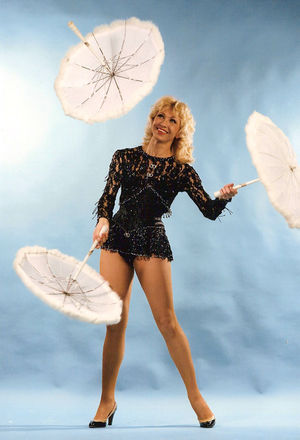Difference between revisions of "Eva Vida"
From Circopedia
| Line 9: | Line 9: | ||
Actually, she and her mother had escaped to Austria, where Eva began her juggling career, and was soon on her way to becoming an international juggling star. | Actually, she and her mother had escaped to Austria, where Eva began her juggling career, and was soon on her way to becoming an international juggling star. | ||
| − | + | She subsequently worked all over the world, on stage and in the ring—including appearances at New York's Radio City Music Hall, in Las Vegas, at the London Palladium, four years at the Casino De Paris, and in South Africa, Australia, Japan, and Russia. She was also featured in several television variety shows in Europe and in the United States. | |
Eva Vida was an excellent technician, juggling flawlessly three umbrellas, five balls with pocket catches (''à la'' [[Kara]]), six rings, and five clubs. She was the co-winner of the Rastelli competition in Bergamo, Italy in 1973—the only woman ever to win that coveted prize, which was then the "Oscar" of the juggling world. | Eva Vida was an excellent technician, juggling flawlessly three umbrellas, five balls with pocket catches (''à la'' [[Kara]]), six rings, and five clubs. She was the co-winner of the Rastelli competition in Bergamo, Italy in 1973—the only woman ever to win that coveted prize, which was then the "Oscar" of the juggling world. | ||
Revision as of 21:38, 3 December 2022
Juggler
Eva Vida was born Éva Vidos in Budapest, Hungary; she sometimes performed under her real name, especially at the beginning of her career—although it was known that Vidos, a clown at the Fővárosi Nagycirkusz (Budapest municipal circus), was not her biological father. Her act was glamorous: She was pretty, sexy, elegant, and her costumes and props were carefully designed to fit her image. Her publicity described her act with the words “Glamour and Novelty.”
She had joined Budapest's State School for Circus and Variety Arts in the 1950s, where she was trained in all traditional circus disciplines (including ballet), and showed a special talent for juggling. In 1956, still at the school, she participated in an ensemble roller-skating act called The 6 Tunde ("The 6 Elves"), with which she toured the country as part of the school's Youth Circus troupe. At the same time, she was seriously trained in juggling by Zoltan Domonkos, a clown known as "Deddy," who built and choreographed a juggling act for her.
1956 was the year when, in October, Budapest rose against the communist regime, which resulted in an armed intervention of the USSR. Many people at the time "disappeared" (i.e. they left the country). When the situation calmed down and the students returned to the circus school, Eva had "disappeared." Actually, she and her mother had escaped to Austria, where Eva began her juggling career, and was soon on her way to becoming an international juggling star.
She subsequently worked all over the world, on stage and in the ring—including appearances at New York's Radio City Music Hall, in Las Vegas, at the London Palladium, four years at the Casino De Paris, and in South Africa, Australia, Japan, and Russia. She was also featured in several television variety shows in Europe and in the United States.
Eva Vida was an excellent technician, juggling flawlessly three umbrellas, five balls with pocket catches (à la Kara), six rings, and five clubs. She was the co-winner of the Rastelli competition in Bergamo, Italy in 1973—the only woman ever to win that coveted prize, which was then the "Oscar" of the juggling world.
Eva Vida passed away in London, where she had retired, on November 8, 2015.
See Also
- Video: Eva Vida, juggler, on ABC TV's Hollywood Palace (1964)
- Video: Eva Vida, juggler, at the Cirque d'Hiver in Paris (1968)
- Video: Eva Vida, juggler, on Italian television (1983)




